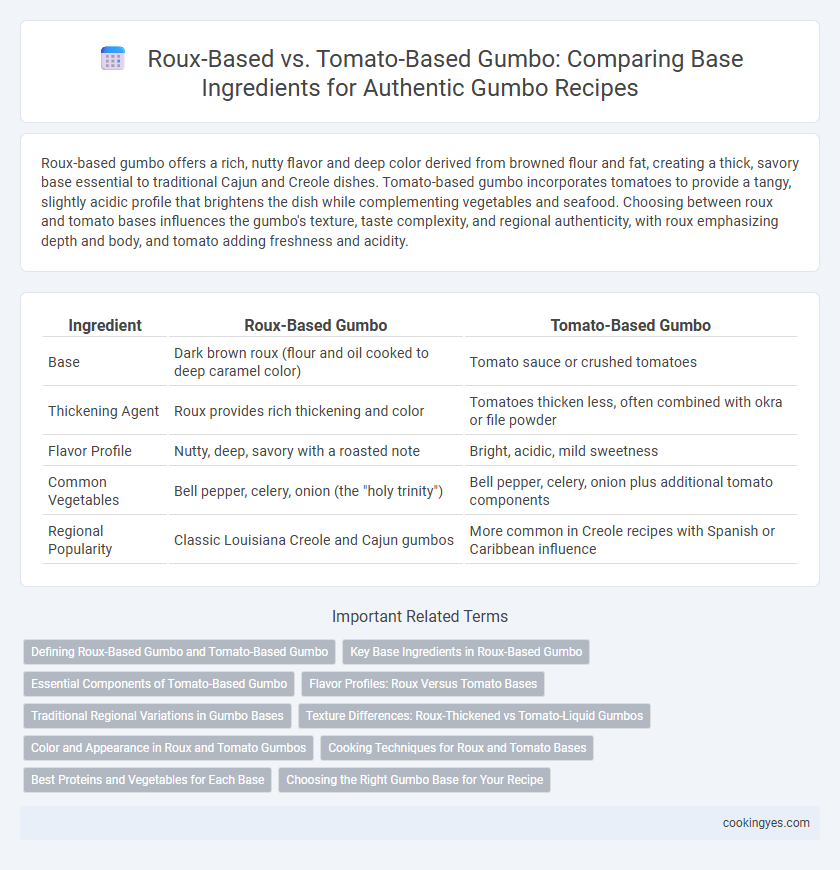Roux-based gumbo offers a rich, nutty flavor and deep color derived from browned flour and fat, creating a thick, savory base essential to traditional Cajun and Creole dishes. Tomato-based gumbo incorporates tomatoes to provide a tangy, slightly acidic profile that brightens the dish while complementing vegetables and seafood. Choosing between roux and tomato bases influences the gumbo's texture, taste complexity, and regional authenticity, with roux emphasizing depth and body, and tomato adding freshness and acidity.
Table of Comparison
| Ingredient | Roux-Based Gumbo | Tomato-Based Gumbo |
|---|---|---|
| Base | Dark brown roux (flour and oil cooked to deep caramel color) | Tomato sauce or crushed tomatoes |
| Thickening Agent | Roux provides rich thickening and color | Tomatoes thicken less, often combined with okra or file powder |
| Flavor Profile | Nutty, deep, savory with a roasted note | Bright, acidic, mild sweetness |
| Common Vegetables | Bell pepper, celery, onion (the "holy trinity") | Bell pepper, celery, onion plus additional tomato components |
| Regional Popularity | Classic Louisiana Creole and Cajun gumbos | More common in Creole recipes with Spanish or Caribbean influence |
Defining Roux-Based Gumbo and Tomato-Based Gumbo
Roux-based gumbo relies on a carefully cooked mixture of flour and fat, usually oil or butter, that creates a rich, dark brown base essential for depth of flavor and thickening. Tomato-based gumbo incorporates crushed or diced tomatoes as a primary ingredient, offering a lighter, tangier profile with acidic notes that balance the dish's spices. Both variations define gumbo's versatility, with roux emphasizing a nutty richness while tomato bases highlight fresh, bright aromas.
Key Base Ingredients in Roux-Based Gumbo
Key base ingredients in roux-based gumbo include a dark roux made from flour and oil, which provides a rich, nutty flavor and thickens the stew. The trio of celery, bell peppers, and onions, known as the "holy trinity," is essential for building depth and complexity. Stock, often chicken or seafood-based, enhances the overall taste, distinguishing roux-based gumbo from tomato-based variations that rely on tomatoes for acidity and sweetness.
Essential Components of Tomato-Based Gumbo
Tomato-based gumbo essential components include diced tomatoes, which provide acidity and a rich, tangy flavor distinct from the nutty, deep flavor of a roux base. Okra is often added for its thickening properties and unique taste, complementing the tomato's brightness. The blend typically features bell peppers, onions, and celery, forming the classic Cajun "holy trinity" that enhances the gumbo's robust, savory profile.
Flavor Profiles: Roux Versus Tomato Bases
Roux-based gumbo delivers a rich, nutty flavor with deep, toasted notes created by slowly cooking flour and oil, enhancing the dish's complexity and providing a thick, velvety texture. Tomato-based gumbo offers a brighter, tangier profile with acidic undertones that balance the spices and seafood, lending a lighter and slightly sweet base. The choice between roux and tomato bases significantly influences the gumbo's overall taste, texture, and regional authenticity, with roux favored in Cajun styles and tomato bases prominent in Creole recipes.
Traditional Regional Variations in Gumbo Bases
Traditional regional variations in gumbo bases highlight the distinct use of roux-based and tomato-based foundations. Roux-based gumbo, prevalent in Cajun and Creole cuisine of Louisiana, relies on a browned flour and fat mixture to achieve a rich, thick texture and deep, nutty flavor characteristic of classic gumbo. Tomato-based gumbo, commonly found in Creole versions, incorporates tomatoes for a tangy acidity that balances the dish, often combined with okra or file powder to thicken and enhance the stew's complexity.
Texture Differences: Roux-Thickened vs Tomato-Liquid Gumbos
Roux-based gumbo features a thick, velvety texture created by slowly cooking flour and fat to develop a rich base that coats each ingredient. Tomato-based gumbo offers a lighter, more liquid consistency with the acidity of tomatoes providing brightness and a thinner broth. The roux-thickened gumbo typically has a denser mouthfeel, while tomato-based gumbo maintains a soupy, vibrant profile.
Color and Appearance in Roux and Tomato Gumbos
Roux-based gumbo features a rich, dark brown hue resulting from the caramelization of flour and fat, giving it a deep, glossy appearance that enhances visual appeal. Tomato-based gumbo presents a vibrant red color from crushed tomatoes or tomato paste, offering a bright and hearty look that contrasts with the darker roux. The choice of base significantly influences the overall color profile and mouth-watering presentation of the gumbo.
Cooking Techniques for Roux and Tomato Bases
Roux-based gumbo requires slow cooking of flour and fat over low heat until it reaches a rich brown color, which imparts deep, nutty flavors and thickens the stew. Tomato-based gumbo involves simmering tomatoes with the holy trinity of vegetables (bell peppers, onions, and celery) to create a tangy, lighter base, often enhancing acidity and freshness. Mastery in controlling roux color and preventing tomato acidity from overpowering the dish is essential for achieving optimal gumbo texture and balance.
Best Proteins and Vegetables for Each Base
Roux-based gumbo pairs exceptionally well with proteins like chicken, sausage, and seafood such as shrimp or crab, while vegetables like okra, bell peppers, onions, and celery enhance its rich, nutty flavor. Tomato-based gumbo benefits from heartier proteins such as beef or pork and complements robust vegetables like tomatoes, green beans, and okra, which contribute acidity and depth. Choosing the right base depends on balancing these protein and vegetable profiles to achieve authentic Cajun or Creole flavors.
Choosing the Right Gumbo Base for Your Recipe
Roux-based gumbo offers a rich, nutty flavor with a thick, velvety texture, making it ideal for recipes requiring depth and robustness. Tomato-based gumbo provides a tangy, slightly acidic profile that enhances seafood and chicken dishes, delivering a lighter, brighter base. Selecting the right gumbo base depends on the desired flavor complexity and the primary ingredients of your recipe, with roux emphasizing richness and tomato highlighting freshness.
Roux-based gumbo vs tomato-based gumbo for base ingredients Infographic

 cookingyes.com
cookingyes.com